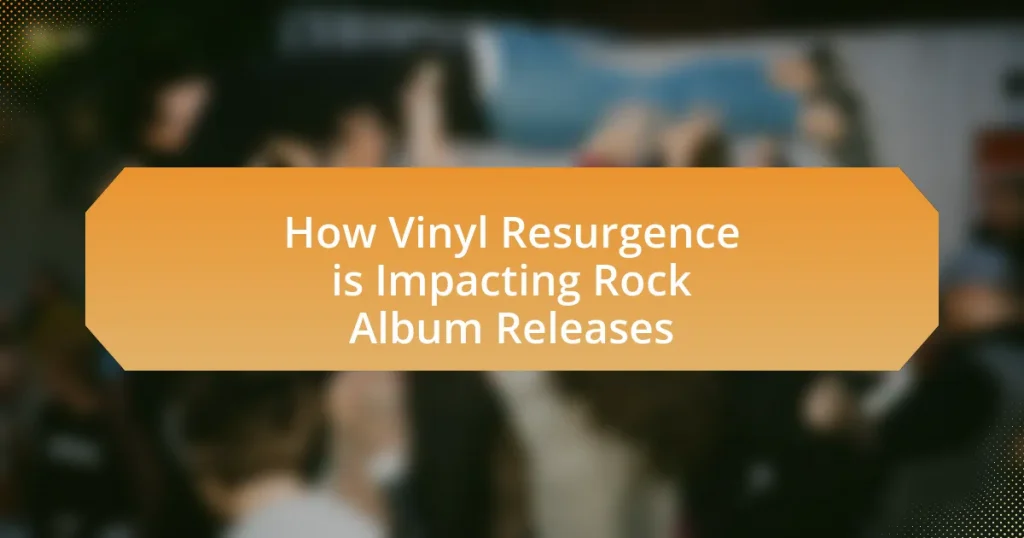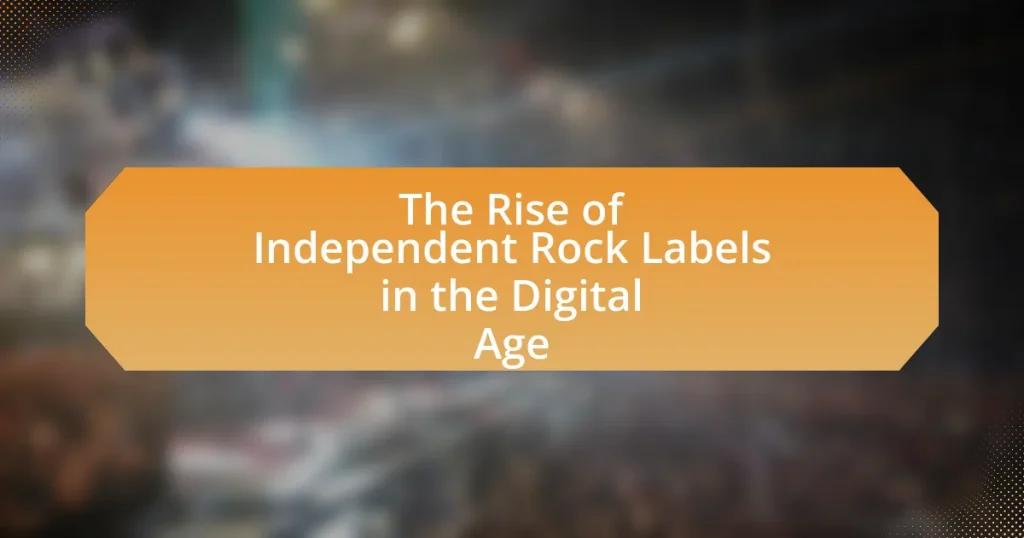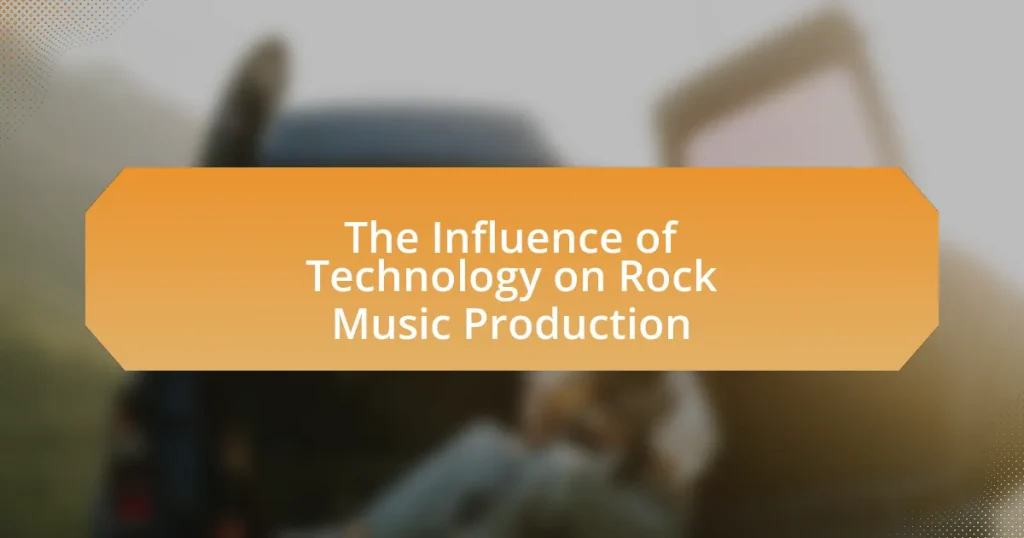The Vinyl Resurgence refers to the significant revival of vinyl records, which has notably influenced the music industry, particularly rock album releases. Since the early 2000s, vinyl sales have surged, surpassing CD sales for the first time in decades, with over 41 million units sold in 2022. This trend is driven by consumer preferences for physical formats, the unique sound quality of vinyl, and the tactile experience it offers, leading artists and record labels to adapt their strategies accordingly. The article explores the factors contributing to this resurgence, its impact on rock music, and the challenges faced by artists and labels in meeting the growing demand for vinyl records.
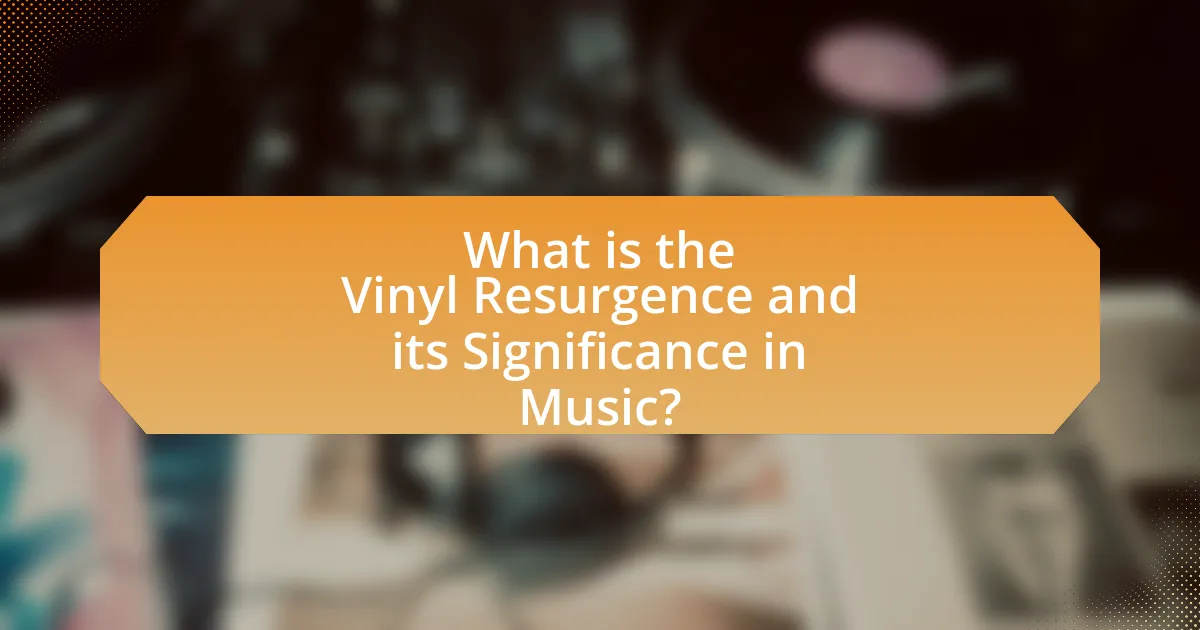
What is the Vinyl Resurgence and its Significance in Music?
The Vinyl Resurgence refers to the renewed popularity and sales growth of vinyl records, which has significantly impacted the music industry since the early 2000s. This trend is characterized by a shift in consumer preference towards physical formats, with vinyl sales surpassing CD sales in 2020 for the first time since the 1980s, according to the Recording Industry Association of America (RIAA). The significance of this resurgence lies in its influence on music consumption, artist promotion, and the overall cultural appreciation of music as an art form, fostering a deeper connection between artists and listeners through tangible media.
How has the popularity of vinyl records changed in recent years?
The popularity of vinyl records has significantly increased in recent years, with sales reaching levels not seen since the 1980s. According to the Recording Industry Association of America (RIAA), vinyl sales in the United States surpassed 41 million units in 2022, marking a 17% increase from the previous year and representing the highest annual sales since 1987. This resurgence is driven by a growing appreciation for analog sound quality, collectible packaging, and the nostalgic appeal of vinyl among both older generations and younger listeners.
What factors have contributed to the vinyl revival?
The vinyl revival has been primarily driven by a resurgence in consumer interest for physical music formats, nostalgia for analog sound quality, and the unique aesthetic appeal of vinyl records. This trend is evidenced by sales data, which shows that vinyl sales in the United States reached 41.7 million units in 2020, the highest level since the 1980s, according to the Recording Industry Association of America (RIAA). Additionally, the tactile experience of handling records and the large-format album art contribute to their appeal, attracting both older generations who grew up with vinyl and younger listeners seeking a more immersive music experience.
How does the vinyl resurgence compare to digital music consumption?
The vinyl resurgence represents a significant cultural shift compared to digital music consumption, emphasizing physical ownership and tactile experience. While digital music offers convenience and instant access, vinyl records provide a unique auditory quality and a nostalgic connection that many listeners find appealing. In 2022, vinyl sales in the U.S. surpassed 41 million units, marking the highest level since the 1980s, while digital downloads have been steadily declining, with a 12% drop reported in the same year. This contrast highlights a growing preference for the analog format among consumers, particularly within the rock genre, where album artwork and the listening experience are integral to the artistic expression.
Why is vinyl particularly appealing to rock music fans?
Vinyl is particularly appealing to rock music fans due to its unique sound quality and tangible experience. The analog format of vinyl records provides a warmth and depth in audio that many enthusiasts believe digital formats cannot replicate. Additionally, the large album artwork and physical interaction of handling records create a more immersive experience, enhancing the emotional connection to the music. This preference is supported by a resurgence in vinyl sales, which reached 41 million units in 2020 in the U.S., indicating a strong demand among music lovers, particularly in the rock genre.
What unique qualities do vinyl records offer for rock albums?
Vinyl records offer a warm, rich sound quality that enhances the listening experience of rock albums. This analog format captures a broader frequency range and provides a dynamic sound that many audiophiles prefer over digital formats. Additionally, the large album artwork and tactile experience of handling vinyl create a more immersive connection to the music, which is particularly significant for rock albums that often emphasize visual artistry and album concepts. The resurgence of vinyl has also led to limited edition releases and unique pressings, appealing to collectors and fans, thereby fostering a deeper appreciation for the genre.
How does the tactile experience of vinyl enhance music enjoyment?
The tactile experience of vinyl enhances music enjoyment by engaging listeners through physical interaction with the medium. Handling vinyl records involves actions such as placing the record on a turntable, carefully lowering the needle, and flipping the record, which creates a ritualistic experience that deepens emotional connection to the music. This engagement contrasts with digital formats, where music is often consumed passively. Studies indicate that physical interaction with music formats can lead to increased satisfaction and a more immersive listening experience, as evidenced by the resurgence of vinyl sales, which reached 41 million units in 2022, highlighting a growing preference for the tactile and auditory qualities of vinyl over digital alternatives.
What impact does the vinyl resurgence have on rock album releases?
The vinyl resurgence has significantly increased the number of rock album releases. In recent years, sales of vinyl records have surged, with the Recording Industry Association of America reporting that vinyl sales reached 41 million units in 2022, the highest level since the 1980s. This renewed interest in vinyl has prompted many rock artists and labels to prioritize vinyl formats for new releases, leading to a revival of both classic albums and new music in this format. Additionally, the tactile and collectible nature of vinyl appeals to fans, encouraging artists to produce limited editions and special releases, further boosting the overall output of rock albums.
How are rock artists adapting to the demand for vinyl?
Rock artists are adapting to the demand for vinyl by increasing their production of vinyl records and incorporating unique packaging and exclusive content. Many artists are recognizing the resurgence of vinyl as a significant market opportunity, leading to a rise in limited edition releases and special pressings that appeal to collectors. For instance, in 2021, vinyl sales in the U.S. surpassed CD sales for the first time since the 1980s, indicating a strong consumer preference for vinyl. This trend has prompted artists to invest in high-quality vinyl production, often including colored vinyl, gatefold packaging, and bonus tracks to enhance the physical product’s appeal.
What trends are emerging in rock album production due to vinyl popularity?
Emerging trends in rock album production due to vinyl popularity include a focus on high-quality audio, limited edition releases, and a return to album-oriented formats. Producers are increasingly prioritizing analog recording techniques to enhance sound quality, as vinyl enthusiasts often seek richer audio experiences. Additionally, artists are creating limited runs of vinyl records, which can drive demand and create a sense of exclusivity. This trend is supported by the resurgence of vinyl sales, which reached 41 million units in 2022, indicating a strong consumer preference for physical formats over digital. Furthermore, there is a renewed emphasis on cohesive album narratives, as artists aim to create immersive listening experiences that align with the traditional vinyl format.

How are Record Labels Responding to the Vinyl Resurgence?
Record labels are responding to the vinyl resurgence by increasing their production of vinyl records and investing in new pressing plants. This shift is driven by a significant rise in vinyl sales, which reached 41 million units in 2022, marking the highest sales since 1987, according to the Recording Industry Association of America (RIAA). In addition to expanding production capabilities, labels are also focusing on exclusive vinyl releases and special editions to attract collectors and enthusiasts, further capitalizing on the growing demand for physical music formats.
What strategies are record labels employing to capitalize on vinyl sales?
Record labels are employing strategies such as limited edition releases, exclusive artwork, and targeted marketing campaigns to capitalize on vinyl sales. These strategies leverage the growing consumer interest in vinyl, which saw a 29% increase in sales in 2020, according to the Recording Industry Association of America (RIAA). By producing limited runs of popular albums or new releases, labels create a sense of urgency and exclusivity that drives demand. Additionally, they often collaborate with artists to design unique packaging and artwork that appeals to collectors. Targeted marketing efforts, including social media promotions and partnerships with independent record stores, further enhance visibility and reach among vinyl enthusiasts.
How are labels balancing digital and vinyl releases?
Labels are balancing digital and vinyl releases by strategically allocating resources to both formats, recognizing the growing demand for vinyl while maintaining the convenience of digital distribution. This approach allows labels to cater to diverse consumer preferences; for instance, in 2022, vinyl sales in the U.S. surpassed CD sales for the first time since the 1980s, indicating a significant market shift. By offering exclusive vinyl editions, often with unique artwork or bonus tracks, labels enhance the physical product’s appeal, while simultaneously leveraging digital platforms for broader reach and accessibility. This dual strategy not only maximizes revenue streams but also fosters a deeper connection with fans who value both the tactile experience of vinyl and the instant access provided by digital formats.
What role do limited edition vinyl releases play in marketing strategies?
Limited edition vinyl releases serve as a strategic marketing tool that enhances brand exclusivity and consumer engagement. By offering unique packaging, colored vinyl, or bonus content, artists and labels create a sense of urgency and desirability among fans, driving sales and fostering a collector’s mentality. For instance, a report from the Recording Industry Association of America (RIAA) noted that vinyl sales reached a 30-year high in 2020, indicating a growing market for physical music formats. This trend demonstrates how limited editions can capitalize on nostalgia and the resurgence of vinyl culture, effectively boosting an artist’s visibility and revenue.
How does the resurgence of vinyl affect new rock artists?
The resurgence of vinyl positively affects new rock artists by providing them with a unique platform to reach audiences and enhance their artistic expression. This revival has led to a significant increase in vinyl sales, with the Recording Industry Association of America reporting that vinyl sales surpassed CD sales for the first time in 2022, indicating a growing consumer preference for physical formats. As a result, new rock artists can leverage this trend to create limited edition releases, which often attract collectors and dedicated fans, thereby increasing their visibility and potential revenue. Additionally, the tactile nature of vinyl encourages a deeper connection between artists and listeners, allowing new rock musicians to present their work in a more immersive and intentional manner.
What opportunities does vinyl provide for emerging rock musicians?
Vinyl provides emerging rock musicians with unique opportunities for artistic expression and market differentiation. The resurgence of vinyl has led to a growing consumer interest in physical music formats, with vinyl sales reaching 41.7 million units in the U.S. in 2022, according to the Recording Industry Association of America. This trend allows new artists to create limited edition releases, enhancing their brand and attracting collectors. Additionally, vinyl’s tactile nature and larger artwork enable musicians to present their work in a more visually impactful way, fostering a deeper connection with fans. The distinct sound quality of vinyl also appeals to audiophiles, creating a niche market that emerging rock musicians can tap into for increased visibility and sales.
How are new artists leveraging vinyl to build their fan base?
New artists are leveraging vinyl to build their fan base by creating limited edition releases and unique artwork that appeal to collectors. This strategy capitalizes on the growing popularity of vinyl, which saw sales increase by 29.2% in 2020, according to the Recording Industry Association of America. By offering exclusive content, such as colored vinyl or bonus tracks, artists attract attention and foster a sense of community among fans who appreciate the tangible and nostalgic aspects of vinyl records.
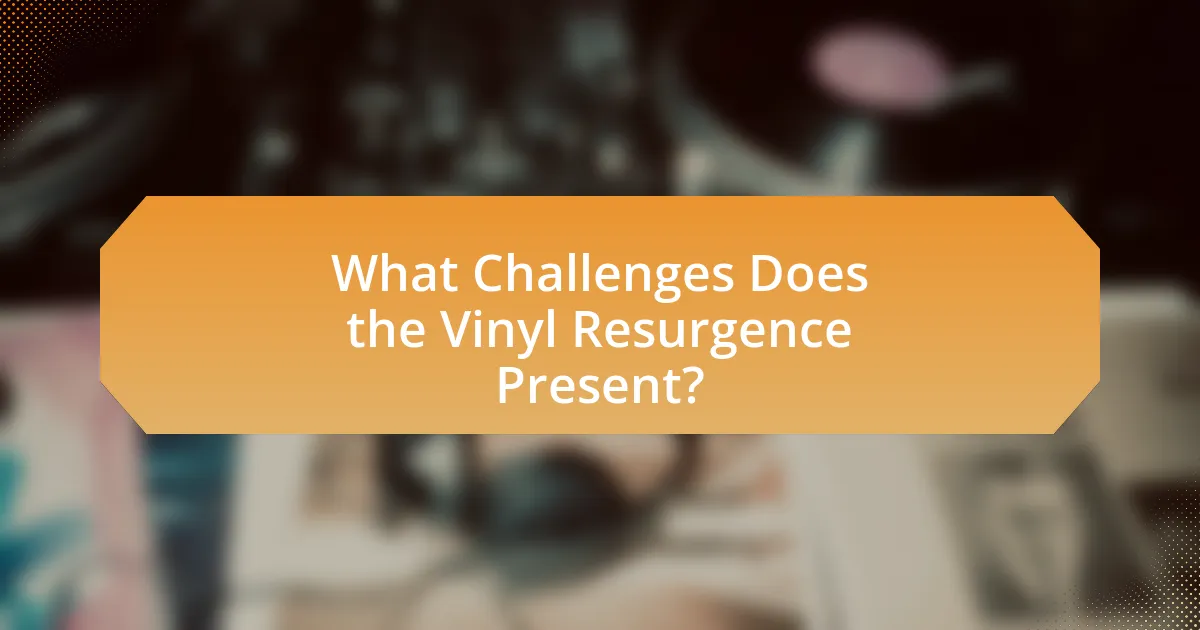
What Challenges Does the Vinyl Resurgence Present?
The vinyl resurgence presents challenges such as supply chain issues, increased production costs, and limited manufacturing capacity. The demand for vinyl records has surged, leading to bottlenecks in production as manufacturers struggle to keep up with orders. For instance, the Vinyl Alliance reported a 50% increase in vinyl sales from 2020 to 2021, which has overwhelmed existing facilities. Additionally, the cost of raw materials, such as PVC, has risen significantly, impacting the overall pricing of vinyl records. These factors create hurdles for artists and labels aiming to release new rock albums in a timely and cost-effective manner.
What production challenges do record labels face with vinyl manufacturing?
Record labels face significant production challenges with vinyl manufacturing, primarily due to limited pressing capacity and longer production times. The resurgence in vinyl popularity has led to increased demand, often outpacing the available manufacturing capabilities, which can result in delays of several months for new releases. Additionally, the vinyl production process is complex, requiring precise quality control to avoid defects such as warping or surface noise, which can further complicate timelines. According to the Record Industry Association of America, vinyl sales reached a 30-year high in 2020, highlighting the strain on production resources as labels strive to meet consumer demand while maintaining quality standards.
How do supply chain issues impact vinyl availability?
Supply chain issues significantly reduce vinyl availability by disrupting the production and distribution processes. For instance, shortages of raw materials, such as PVC, and delays in shipping due to global logistics challenges have led to longer lead times for vinyl pressing plants. According to a report from the Recording Industry Association of America, the demand for vinyl records surged by 29% in 2020, but production capacity has struggled to keep pace due to these supply chain constraints. Consequently, this imbalance results in limited stock for retailers and longer wait times for consumers seeking new releases.
What are the environmental concerns associated with vinyl production?
Vinyl production raises significant environmental concerns primarily due to the use of polyvinyl chloride (PVC), which is a petroleum-based plastic. The production process of PVC involves the release of harmful chemicals, including dioxins, which can contaminate air and water. Additionally, the manufacturing of vinyl records generates substantial waste and energy consumption, contributing to carbon emissions. According to a study by the European Commission, the lifecycle of PVC can result in a high environmental impact, particularly in terms of resource depletion and pollution. Furthermore, the disposal of vinyl records poses challenges, as they are not biodegradable and can persist in landfills for hundreds of years, exacerbating plastic pollution.
How does the vinyl resurgence influence pricing and accessibility?
The vinyl resurgence has led to increased prices and limited accessibility for consumers. As demand for vinyl records has surged, prices have risen significantly; for instance, the average price of a new vinyl record increased from $15 in 2009 to over $30 in 2021, according to the Recording Industry Association of America. This price hike is partly due to the revival of vinyl manufacturing, which has not kept pace with the growing demand, resulting in longer wait times and limited stock for popular titles. Consequently, while vinyl records have become a sought-after collectible, this trend has made them less accessible to casual listeners and new collectors, who may find it challenging to afford or locate specific albums.
What factors contribute to the rising costs of vinyl records?
The rising costs of vinyl records are primarily driven by increased production expenses, limited supply, and heightened demand. Production costs have surged due to the rising prices of raw materials, such as PVC, and the labor-intensive manufacturing process, which includes pressing and quality control. Additionally, the resurgence of vinyl has led to a limited supply of pressing plants, resulting in longer wait times and higher prices for production services. Demand has significantly increased, with vinyl sales reaching over 41 million units in 2022 in the U.S. alone, according to the Recording Industry Association of America. This combination of factors creates a market where prices continue to rise as consumers seek physical music formats.
How can consumers find affordable vinyl options in a growing market?
Consumers can find affordable vinyl options in a growing market by exploring online marketplaces, local record stores, and discount retailers. Online platforms like Discogs and eBay often feature competitive pricing and a wide selection, allowing consumers to compare prices easily. Local record stores frequently have sales or used vinyl sections where prices are lower, and discount retailers may carry new releases at reduced rates. According to a 2022 report by the Recording Industry Association of America, vinyl sales have surged, leading to increased competition among sellers, which can drive prices down.
What are the best practices for rock artists releasing albums on vinyl?
The best practices for rock artists releasing albums on vinyl include ensuring high-quality audio mastering, selecting durable and visually appealing packaging, and effectively marketing the release to target audiences. High-quality audio mastering is crucial because vinyl has specific sound characteristics that require careful attention to detail; for instance, mastering for vinyl often involves adjusting levels to prevent distortion during playback. Durable packaging, such as gatefold covers or thick cardboard sleeves, not only protects the vinyl but also enhances the visual appeal, which can attract collectors and fans. Effective marketing strategies, including social media campaigns and limited edition releases, can create buzz and drive sales, as evidenced by the 2021 report from the Recording Industry Association of America, which noted that vinyl sales reached a 30-year high, indicating strong consumer interest.
How can artists effectively market their vinyl releases to fans?
Artists can effectively market their vinyl releases to fans by leveraging social media platforms, engaging in targeted promotions, and creating exclusive content. Social media allows artists to reach a broad audience, with 79% of the U.S. population using platforms like Instagram and Facebook, which can be utilized to announce vinyl releases, share behind-the-scenes content, and connect with fans directly. Targeted promotions, such as limited-time offers or bundle deals, can create urgency and encourage purchases, as evidenced by the 30% increase in vinyl sales during promotional events. Additionally, offering exclusive content, such as signed copies or special artwork, can enhance the perceived value of the vinyl, appealing to collectors and dedicated fans.
What should artists consider when designing album artwork for vinyl?
Artists should consider the physical dimensions and tactile experience of vinyl when designing album artwork. The larger canvas of a vinyl cover allows for more intricate and visually striking designs, which can enhance the overall aesthetic and emotional impact of the music. Additionally, artists should think about the color palette and imagery, as these elements can evoke specific feelings and connect with the album’s themes. The choice of materials, such as matte or glossy finishes, also plays a crucial role in how the artwork is perceived. Historical trends show that iconic album covers, like Pink Floyd’s “The Dark Side of the Moon,” have significantly contributed to the album’s legacy, demonstrating the importance of thoughtful design in creating a lasting impression.
